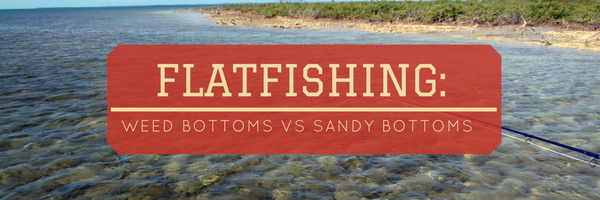When it comes to fishing for bonefish, experts don’t always agree on choosing sandy or weedy flats. There are those who swear by sand, saying that it’s the best way to spot the fish. Others love to explore the weeds, since they feel that’s the place where the bonefish feels least vulnerable.
At East End Lodge, we agree with both schools of thought. There are seasons and days when looking for bonefish in the sandy flats is the most rewarding. Other days the weeds prove to be the place to be. Let’s take a look at the habits of the bonefish to help explain this.
Bonefish are bottom feeders. They spend their time scouring the ocean floor for a meal. Clams, crabs, worms, shrimp and mud minnows are all on the menu. Because bonefish are laser focused on the ocean floor, it’s imperative that whatever fly you use sinks quickly. Usually, our guides recommend that a fly should sink within two to three seconds. This way, your fly is already on the bottom as the bonefish approaches. The first strip will successfully mimic the behavior of startled prey.
That quick sinking is crucial when you’re fishing on the sandy flats. With virtually no cover, it’s hard to fool a sharp-eyed bonefish into thinking that your fly is a crab or a shrimp. December through June is the best part of the year for spotting bonefish on the sandy flats. That’s because the shallow water, 6” – 18”, isn’t too hot for the comfort of the fish. As things heat up, especially in July and August, the bonefish tend to migrate to weedier areas where the water is deeper, 1’ – 3”, and temperatures are more comfortable.
This doesn’t mean that you have to give up your quest for bonefish during the hottest months of the year. Many of our guests have rewarding experiences while they are fly-fishing in the weedier areas. You’ll need a heavier fly so that the sink rate will be slower. This gives the bonefish an opportunity to spot the fly before it disappears into the surrounding weeds. Weedguards are NOT the preference of our guides and as long as your trust their instruction with quick short strips you will be fine.
Some people hate to use weedguards, but our guides can share tips and advice that may take the headaches out of the process. Remember, it’s pretty easy to cut a weedguard off, but it’s more difficult to attach it. This may make it sensible to start off with the weedguard. Then, if it starts getting in the way, it’s easy enough to get rid of.
Bonefish can be found in sandy flats and in the weeds. Depend on your experienced guide from East End Lodge to help you figure out where the fishing is most promising and which flies may be most successful.









